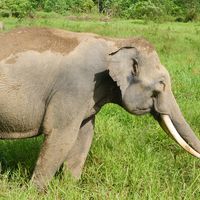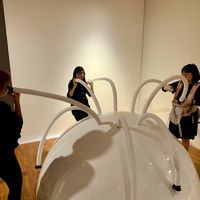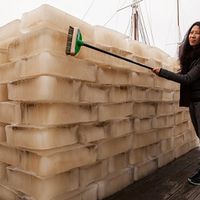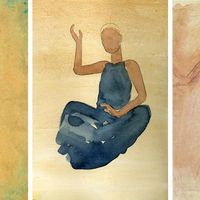#artsandtechnology: New digital aesthetics of the natural world | Finland

culture360.ASEF.org features Invisible Flock, as an introduction to our new series of articles on #artsandtechnology. Invisible Flock is an interactive arts studio operating at the intersection of art and technology, they create highly sensory installations and environments that ask audiences to renegotiate their emotional relationship to the natural world. In this article, Ben Eaton, Technical Director, Invisible Flock, explores the use of technology in capturing data from landscapes in Finland and re-imagining this data through sensory installations.
Using a technology driven process is our way of engaging more deeply with nature and how we strive to create a deeper understanding of the natural world for our audiences.
Technology and urbanism are often considered in the same sentence, the futurism of our tech centered world tends to lend itself to visions of cities, networks and interconnected people. As artists working on the edges of conservation and research, we have been exploring the new digital aesthetics through which to approach nature.
We have been exploring how technology driven techniques can create experiences for audiences that bring them closer to nature and the ecosystems that our work focuses on.
We set out to try and capture landscapes in ways that go beyond the pastoral or the ‘Instagramable’ moment of fake isolated beauty. We set out to try and take full imprints of a place, capturing not just what we can see, but what we can hear, breathe and sense the stories that haunt a place and perhaps crucially the things that we cannot perceive.
This is part of an ongoing experimental process for us that first began in Indonesia, with a work we created with our friends and colleagues, Digital Nativ, who are based in Jakarta. A series of field trips to unique ecosystems, where we collected physical samples of earth and rocks, took data readings of air quality, analysed water, recorded sound, captured colours and the imperceptible electrical signals emitted by plants.
These all came together through a series of synthesised environments and glass tubes, with each one holding within it an abstraction of an ecosystem. In one, the coral was slowly washed back and forth, breaking it down into the pink dust from the famous pink beach; which is becoming less pink and the coral becoming more bleached.
Volcanic sand was activated with the roaring sound of the active volcano, recreating the landscape of Mount Bromo from cymatics. We describe it as boiling down a landscape into a highly concentrated version of itself.
We are currently working in Finland where we are conducting a similar study of the landscape. The scientists, activists, artists and people we meet there show that landscape is everything. In a country that is 70% forest, there is a sense that the stillness and vastness is not just something that is observed but something that is felt deeply.

Forest at the Oulanka Research Station in Northern Finland (Photo Credits: Invisible Flock)
In trying to capture and somehow express the landscape of the Finnish north, we want to capture both its beauty but also the complexities that reside in many of the countries that we understand as being ‘green’. To that end, we are experimenting not only with place but also with time, trying to capture the deep time of ecological life.
Part of this involves a process we are developing from long form sound recordings, capturing the sound of natural events over months and using time as a material. The duality of freeze and thaw is central to Finnish culture as much as to Finnish nature and is one of the centers of our focus. Our work is a study in freeze, itself a disappearing and changing phenomenon as global temperatures creep higher. What does a country’s freezing sound like, how can we recreate the alchemy of water turning to ice?
Our work Aurora created in the summer of 2018 for Liverpool was a work that contemplated water, in its beautiful and destructive force, using both as an element and a material. We flooded a large space and invited the audience to experience water as it enveloped them sonically, visually and physically. Ice was a major component of the work, suspended in 40 blocks from the vaulted ceiling of the space, it performed ballets of slow movement and created aurora borealis effects as we shot high powered lasers through the blocks. It was a deeply moving and immersive experience that sought to bring people almost unbearably close to water as a spiritual force as much as a natural one.
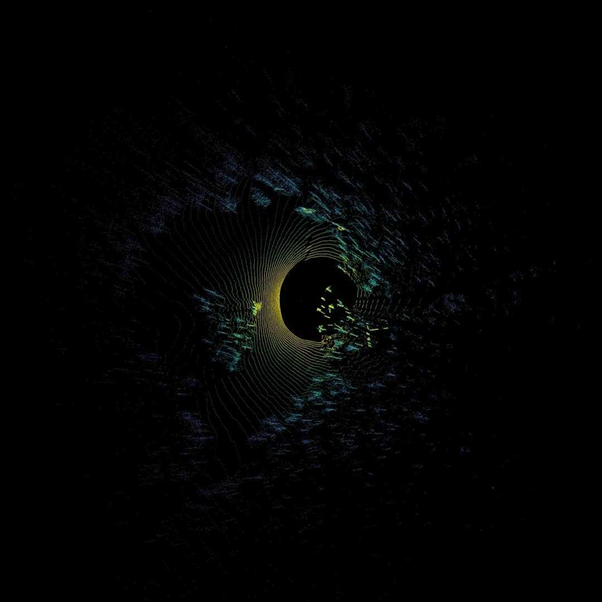
LIDAR scan of the Forest at Oulanka Research Station (Photo Credits: Invisible Flock)
In thinking of Finland, we find ourselves talking about wild ice. Ice wrought out of air and rain, forming a second topography on top of the landscape, a faster geology of ice and wind, never the same twice. Capturing that topography through a series of drone flights, we have begun to build 3D models that capture the shapes of the landscapes. We are then experimenting with reproducing them carved from an organic object that is the perfect representation of the deep time we are exploring.
Peat lands are being drained in the north of the country, partly to use the peat as fuel and also to access the land underneath for mining. One of the waste products of this process is tree trunks, thousands of years old that fell into the peat and were preserved for millennia. By salvaging this wood, not only are we drawing lines that connect the fragility of the landscape to the destructive practices of the extractive industries, but we are also carving and machining objects that exist on time scales we could never truly perceive and understand. Our 3D CNC machine carves out the landscapes into these artefacts snatched from time, ancient carbon imprinted with a disappearing landscape.

Photogrammetry from Oulanka research station carved out by CNC onto 3,000-year-old spruce extracted during peat mining (Photo Credits: Invisible Flock)
This is all early in the process of making this work, and these experiments in capture are driven by the scientists we meet. Working in a research station on the edge of the Arctic Circle gives us access to researchers working directly in the field of changing environment, running experiments that are decades long, designing methodologies and protocols that will outlive them. Time.
An expert in soil once told us ‘we don’t live long enough to perceive change’. To collapse time and allow us to perceive it as it plays out on a landscape becomes more than an act of art or poetry. Instead, it becomes a critical practice of better understanding this age of change that we are bringing about.
To know more about the development of the project in Finland:
Drone footage from selected site research in Finland: https://vimeo.com/342738857/0d0bc36448
Video footage for project development of project in Finland: https://vimeo.com/356669673
Video footage of Aurora: https://vimeo.com/360780627
This article is written by Ben Eaton, Technical Director at Invisible Flock. Creating highly sensory installations and environments that ask audiences to re-negotiate their emotional relationship to the natural world, believing that art today must have a positive impact on society and the world we live in and artists have a responsibility to open up collective thinking and to build space for critical enquiry. Drawing directly from the world around us, Invisible Flock aims to create art and foster relevant art practices that have a long-lasting transformative effect and sit across multiple contexts and adjacent sectors.
Similar content
from - to
20 Jun 2014 - 06 Jul 2014
from - to
24 Jan 2012 - 05 Feb 2012
deadline
10 Jun 2019

